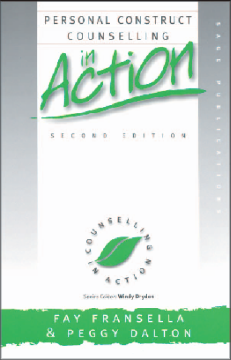
Additional Information
Book Details
Abstract
SAGE celebrated the 20th Anniversary of the Counselling in Action in November 2008. To view the video - click here
--------------------------------------------------------------
Praise for the First Edition
`In Britain, few people can have contributed more to the development of a personal construct approach than Fay Fransella and Peggy Dalton.... Their book is primarily written for those who may wish to incorporate Kelly's ideas into their existing counselling framework.... This is an informative book which is concise, well-written and with no shortage of clinical examples, relevant to all who are interested in counselling and psychotherapy' - British Journal of Psychology
The revised and updated edition of this practical, accessible book gives a clear introduction to personal construct counselling for counselling trainees and practitioners alike. Outlining the key principles of the personal construct approach to counselling and relating them to practice, the book carefully explores ways in which counsellors, through credulous listening to everything the client says - and does not say - can build the client's awareness of the manner in which he or she construes problems. The range of methods that can be used to help the counsellor and client learn more about inherent contradictions and their implications, are described and illustrated.
The book goes on to show how the counsellor and client in partnership can then devise experiments for change through which the client can try out new and more rewarding ways of constructing and acting. A number of approaches to facilitating change are discussed and exemplified.
Table of Contents
| Section Title | Page | Action | Price |
|---|---|---|---|
| Prelims [About the authors |Foreword |Preface |Acknowledgements |Abbreviations and acronyms | Key people in the history of AMK] | |||
| Prologue: Seila’s story | |||
| Introduction: Going beyond good intentions | |||
| Building a business model for good | |||
| Does it work? | |||
| A brief history | |||
| Part I Shedding assumptions about clients | |||
| Meeting needs as well as wants | |||
| Ensuring access | |||
| Balancing the needs of different groups | |||
| Chapter 1 Insight: Don’t just offer products; respond to client needs | |||
| Understanding client livelihoods | |||
| Designing products that respond to needs | |||
| Looking ahead | |||
| Chapter 2 Insight: Ask good questions; have good conversations | |||
| Asking good questions | |||
| Having good conversations | |||
| Using data better | |||
| Looking ahead | |||
| Part II Translating good intentions | |||
| Managing what matters | |||
| The end of ‘command and control’ | |||
| Chapter 3 Insight: Do what it says on the tin | |||
| Laying the foundation for growth | |||
| Stress testing the model | |||
| Learning the lessons | |||
| Looking ahead | |||
| Chapter 4 Insight: Motivate staff to do difficult work in an excellent way | |||
| Creating a learning culture | |||
| Supporting the learning culture | |||
| Building the right Board to deliver value | |||
| Looking ahead | |||
| Part III Building a business model that works | |||
| Choosing the dirt road | |||
| An evolving business model | |||
| Chapter 5 Insight: Own the dirt road | |||
| At war with conventional wisdom | |||
| AMK’s ‘outside-in’ strategy | |||
| Making the maths work | |||
| Maintaining a focus on poor people | |||
| Looking ahead | |||
| Chapter 6 Insight: Adapt to the changing landscape | |||
| Balancing your offering with capacity and context | |||
| The dangers of standing still | |||
| Exploring the limits of the product offering | |||
| The savings story: Bringing it all together | |||
| Looking ahead | |||
| Conclusions: Taking the road less travelled | |||
| How can we do better at doing good? | |||
| One organization in a big world | |||
| Looking forward |
